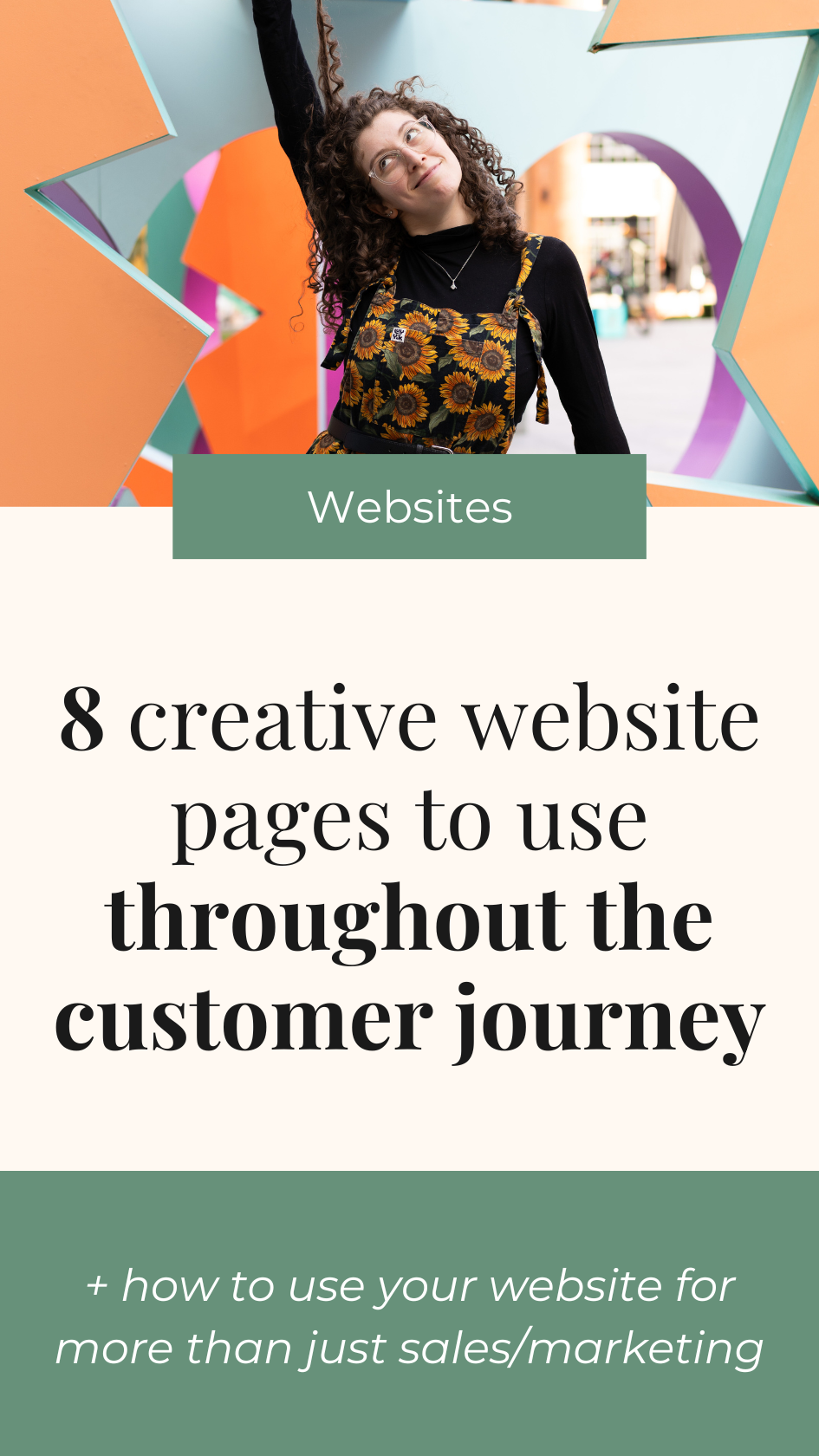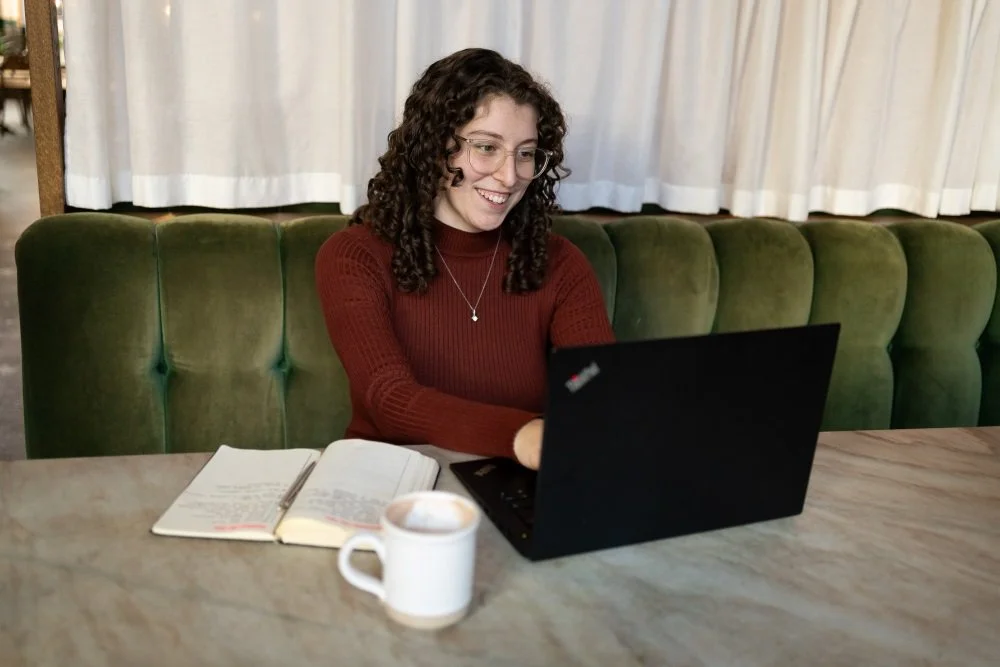8 website pages you can use throughout your customer journey
When we think of websites, we often think of your standard pages - Home, About, Services, Contact. But your website can actually be so much more than that and work hard for you in your business.
The idea here is to think of creative ways your website can be leveraged throughout the customer journey, allowing for more take-your-breath-away touch points and ability to wow your clients.
When I work with clients to design websites, we always spend time strategizing and coming up with creative ideas such as those shared in this article.
This blog post will share 7 unique ideas for website pages you may not have thought of before.
1.Resources Page
A resources page is a page which pulls together all of your favourite resources/recommendations/links into one place and acts as a helpful resource for potential clients or website visitors.
This is especially helpful if you have affiliate links for products you love as this page is where you can bring them altogether. Just make sure your page includes a disclaimer so that people are aware when links are affiliate links.
These also work well as a page you can refer people to if you get asked about what you tools you used to do X, what equipment you use, or what courses recommend for people who want to get started in your industry.
It is also a great opportunity to link your own resources, such as your most popular blog posts / low-ticket products / your podcast.
Things you could include on your resources page includes:
Favourite books / podcasts
Courses you’ve taken
Affiliate links
Freebies / Lead-Magnets
Your favourite software for running your business.
Equipment you use e.g. filming equipment / cameras
Low ticket products e.g. spreadsheets/guides/templates/formulas
Links to great examples of a resource page includes:
Kerstin Martin’s Calm Business Toolbox
Laptop Lifestyle Co’s Resources Page
2. Onboarding Page
When you take on a new client, there are probably a few steps you go through every time, like signing your contract, booking a kick-off call, watching a welcome video, understanding what it looks like to work with you.
Maybe right now, your onboarding process is done manually via email or via an automated system. But what if you could take away this step and have it all on one easy-to-follow page that your client is directed to when they buy from you. Simply send them the link to your onboarding page and it has all the info they need to know.
You could even have different onboarding pages for your different offers. E.g. your group programme, vs your 1 on 1 coaching.
Your client onboarding page could include:
Your welcome video explaining next steps & what to expect when working together
Links to join your communication channel e.g. WhatsApp group, Slack or Geneva, Facebook group
Quick links e.g. your course login page, links to book a call with you, recurring zoom links
Next step instructions e.g. sign your contract, book a call, add dates to your calendar
Embed your booking software to book your kick-off call
Simple bullet points explaining what to expect
Links to useful guides e.g. how to give feedback, what to do when X happens
Answer FAQs
Next out of office dates
3. Offboarding Page
Similar to your onboarding page, your offboarding page can help you to make those repititive offboarding tasks even easier.
Rather than sending a couple of emails that you send to every client, create an offboarding page instructing them on next steps.
Your offboarding page could include:
Thank you for working with me video
Testimonial request
Link to your Google My Business profile to leave a review
How to get in touch with you now the project is over
Introduce offer to continue working with you
Form to join your email list for future updates
Invite to join your community e.g. Facebook Group
Introduce your referral programme (see below for more details)
4. Referral Page
One of the best ways to grow your business is through referrals and word of mouth. But why leave it to chance? By creating a referral programme for your business, you can actively encourage page/current clients to refer potential clients to you.
One way to make this easier is through a referral page on your website, which outlines the referral programme and encourages people to send others your way. Simply send an email with the details and share a link to your referral page which explains in more detail, and allows referral partners to refer back to.
Your referral programme could include a £50 gift card for every client that signs, a 10% commission or “one-month-free” working with you. Whatever reward you choose, simply add the details to your referral page so that it is easy to refer back to.
Examples of what you can include on your referral page:
Detail the benefits of referrals (for the past/current client e.g. reward/commission)
Provide email templates / wording they can send to their email list or contacts
Who are your best fit clients?
What can you help with?
Links to any form / application they need to complete to be a referral partner
5. Coffee Chats / Call Booking Pages
My coffee chat page is one of my most used pages on my website. It essentially invites people to book a 20-minute coffee chat with me and has my calendar imbedded in the page so they can book a slot directly on my calendar.
For me, 20 minutes has been the perfect timeslot for anyone you meet networking, anyone you want to get to know a little better, or for booking time to discuss any potential collaborations.
I use Acuity scheduling as my booking software as it integrates directly with my Squarespace website, but you could also embed other tools like Calendly or Dubsado.
The great thing about these tools is they sync to your calnedar so it will block out time depending on your availability. That means goodbye back-and-forth emails trying to find a time that works for you both. They also automatically include a link to your chosen video meeting tool such as Zoom or Google Meet, and it can send automatic reminders a day/hour before. That means no need to manually send reminder emails or call confirmations.
But coffee chats aren’t the only thing you can use a call booking tool for - you can create pages for all the different time slots / call types you have in your business:
Some examples of call booking pages could include:
Coffee Chats
Discovery / Consultation Calls
1:1 Coaching Calls
Kick-off calls
Strategy Calls
Weekly/Monthly Check-Ins
Want to check out my coffee chats page? Here is a link to book a call directly on my calendar and get to know each other a little better. No sales, just a lovely chit chat and get to know one another.
6. Media Kit
A media kit page is a page on your website which pulls together important information for press/bloggers to create content about your brand, or to attract brand-partnerships, particularly if you are a content-creator. In the small-business world, they are often also used to attract more collaborations, interviews, speaking opportunities and podcast features.
The idea of a media kit is to make it as easy as possible for potential press/partners/collaborators to get all of the important information about you, quickly. This information most commonly includes a bio about you, social media follower stats and past achievements/features.
Media kits are also particularly helpful for positioning yourself as an expert, showcasing past features and inviting future collaborations.
Some examples of what to include in your media kit page:
Key media stats e.g. number of followers on different platforms, email subscribers, number of past clients
Captivating bio introducing yourself
Headline-worthy details about you and your story
Links to your social media pages
Links to past features/interviews
Logos of where you have been featured
Interview/Speaking topics
Example Media Kits:
7. Custom Thank You Pages
Thank you pages are one of the most underutilised pages on any website because people who land on your thank you pages are your most engaged audience.
Your thank you page is the page that a user gets redirected to when they download your freebie or complete your contact form.
By creating a custom thank you page, you can track conversions on your website and capture this already-engaged audience. They are also a great opportunity to come up with creative ways to continue to capitalise on this engagement.
Want to check out my thank you page?
Download my free website project planner and you’ll be redirected so you can be nosy, AND hop on my email list of weekly emails.
Examples of what you could include on a thank you page:
Thank you video
Tripwire product
Market research survey
You might find my other blog post helpful if you want more ideas on what to include on your custom thank you page, and how to build a thank you page on Squarespace.
8. Link In Bio Page
Last but not least is a custom link-in-bio page, commonly known as a LinkTree. These are the pages you link directly from your social media platform in your bio, and collate all your quick links so they’re easy to access.
Rather than using a third party platform like LinkTree, it can be super benefical to create a link-in-bio page directly on your website. It allows you to have full creative control, sends traffic directly to your website and looks a lot more professional.
When creating one, make sure you design it with mobile view in mind, rather than desktop as most people clicking the link in your bio will be accessing it from their phones.
Here are some examples of what you can link on your link-in-bio page:
Links you reference in your posts/highlights
CTAs to book a call with you
Link your freebie / lead magnet
Conclusion
As you can see from this blog post, there are so many powerful ways you can make use of your website that go far beyond your basic home/about/contact pages. Your website can truly be the beating heart of your business and enhance your client experience throughout the customer journey - not just sales and marketing.
Want to work with a web designer that goes beyond basic and will create a powerful tool for your business? Check out my website design services to learn more about how we can work together.
Want to work with a website designer who will help you think outside the box and help you streamline your business? Check out my web design services to see how we can take your website from static to a powerful tool in your business.



